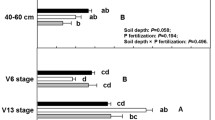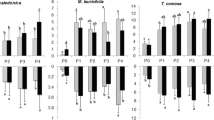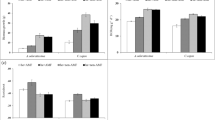Abstract
To investigate whether arbuscular mycorrhizal fungi (AMF) – abundant in a phosphate-polluted but nitrogen-poor field site – improve plant N nutrition, we carried out a two-factorial experiment, including N fertilization and fungicide treatment. Percentage of root length colonized (% RLC) by AMF and tissue element concentrations were determined for four resident plant species. Furthermore, soil nutrient levels and N effects on aboveground biomass of individual species were measured. Nitrogen fertilization lowered % RLC by AMF of Artemisia vulgaris L., Picris hieracioides L. and Poa compressa L., but not of Bromus japonicus Thunb. This – together with positive N addition effects on N status, N:P-ratio and aboveground biomass of most species – suggested that plants are mycorrhizal because of N deficiency. Fungicide treatment, which reduced % RLC in all species, resulted in lower N concentrations in A. vulgaris and P. hieracioides, a higher N concentration in P. compressa, and did not consistently affect N status of B. japonicus. Evidently, AMF had an influence on the N nutrition of plants in this P-rich soil; however – potentially due to differences in their mycorrhizal responsiveness – not all species seemed to benefit from a mycorrhiza-mediated N uptake and accordingly, N distribution.



Similar content being viewed by others
Abbreviations
- AM:
-
Arbuscular mycorrhiza
- AMF:
-
Arbuscular mycorrhizal fungi
- % RLC:
-
Percentage of root length colonized
References
Al-Karaki GN (1998) Benefit, cost and water-use efficiency of arbuscular mycorrhizal durum wheat grown under drought stress. Mycorrhiza 8:41–45
Baylis GTS (1975) The magnolioid mycorrhiza and mycotrophy in root systems derived from it. In: Sanders FE, Mosse B, Tinker PB (eds) Endomycorrhizas. Academic, London, pp 373–389
Blanke V, Renker C, Wagner M, Füllner K, Held M, Kuhn AJ, Buscot F (2005) Nitrogen supply affects arbuscular mycorhizal colonization of Artemisia vulgaris in a phosphate-polluted field site. New Phytol 166:981–992
Blanke V, Schulze B, Gerighausen U, Küster S, Rothe R, Schulze H, Siñeriz M (2007) The power of regeneration: lessons from a degraded grassland. Restor Ecol 15:307–311
Bobbink R (1991) Effects of nutrient enrichment in Dutch chalk grassland. J Appl Ecol 28:28–41
Brouwer R (1983) Functional equilibrium: sense or nonsense? Neth J Agric Sci 31:335–348
Bücking H, Shachar-Hill Y (2005) Phosphate uptake, transport and transfer by the arbuscular mycorrhizal fungus Glomus intraradices is stimulated by increased carbohydrate availability. New Phytol 165:899–912
Cameron DD (2010) Arbuscular mycorrhizal fungi as (agro)ecosystem engineers. Plant Soil 333:1–5
Chambers CA, Smith SE, Smith FA (1980) Effects of ammonium and nitrate ions on mycorrhizal infection, nodulation and growth of Trifolium subterraneum. New Phytol 85:47–62
Chen S-K, Edwards CA, Subler S (2001) Effects of the fungicides benomyl, captan and chlorothalonil on soil microbial activity and nitrogen dynamics in laboratory incubations. Soil Biol Biochem 33:1971–1980
Daft MJ, Nicolson TH (1969) Effect of Endogone mycorrhiza on plant growth. New Phytol 68:945–952
Dhillion SS, Gardsjord TL (2004) Arbuscular mycorrhizas influence plant diversity, productivity, and nutrients in boreal grasslands. Can J Bot 82:104–114
Francis R, Read DJ (1995) Mutualism and antagonism in the mycorrhizal symbiosis, with special reference to impacts on plant community structure. Can J Bot 73(Suppl):S1301–S1309
Frey B, Schüepp H (1993) Acquisition of nitrogen by external hyphae of arbuscular mycorrhizal fungi associated with Zea mays L. New Phytol 124:221–230
Govindarajulu M, Pfeffer PE, Jin H, Abubaker J, Douds DD, Allen JW, Bücking H, Lammers PJ, Shachar-Hill Y (2005) Nitrogen transfer in the arbuscular mycorrhizal symbiosis. Nature 435:819–823
Grime JP, Hodgson JG, Hunt R (2007) Comparative plant ecology - a functional approach to common British species. Castlepoint, Dalbeattie
Grogan P, Chapin FS III (2000) Nitrogen limitation of production in a Californian annual grassland: the contribution of arbuscular mycorrhizae. Biogeochemistry 49:37–51
Güsewell S (2004) N:P ratios in terrestrial plants: variation and functional significance. New Phytol 164:243–266
Harrison MJ (2005) Signalling in the arbuscular mycorrhizal symbiosis. Annu Rev Microbiol 59:19–42
Hart MM, Reader RJ, Klironomos JN (2003) Plant coexistence mediated by arbuscular mycorrhizal fungi. Trends Ecol Evol 18:418–423
Hartnett DC, Wilson GWT (1999) Mycorrhizae influence plant community structure and diversity in tallgrass prairie. Ecology 80:1187–1195
Hartnett DC, Wilson GWT (2002) The role of mycorrhizas in plant community structure and dynamics: lessons from grasslands. Plant Soil 244:319–331
Hawkins H-J, George E (1999) Effect of plant nitrogen status on the contribution of arbuscular mycorrhizal hyphae to plant nitrogen uptake. Physiol Plant 105:694–700
Hawkins H-J, Johansen A, George E (2000) Uptake and transport of organic and inorganic nitrogen by arbuscular mycorrhizal fungi. Plant Soil 226:275–285
Heinrich W, Perner J, Marstaller R (2001) Regeneration und Sekundärsukzession - 10 Jahre Dauerflächenuntersuchungen im Immissionsgebiet eines ehemaligen Düngemittelwerkes. Z Ökol Naturschutz 9:237–253
Held M, Baldwin IT (2005) Soil degradation slows growth and inhibits jasmonate-induced resistance in Artemisia vulgaris. Ecol Appl 15:1689–1700
Hendershot WH (1985) An inexpensive block digester for nitrogen determination in soil samples. Commun Soil Sci Plant Anal 16:1271–1278
Hetrick BAD, Wilson GWT, Todd TC (1992) Relationships of mycorrhizal symbiosis, rooting strategy, and phenology among tallgras prairie forbs. Can J Bot 70:1521–1528
Hodge A, Berta G, Doussan C, Merchan F, Crespi M (2009) Plant root growth, architecture and function. Plant Soil 321:153–187
Hodgson JG, Wilson PJ, Hunt R, Grime JP, Thompson K (1999) Allocating C-S-R plant functional types: a soft approach to a hard problem. Oikos 85:282–294
Janos DP (2007) Plant responsiveness to mycorrhizas differs from dependence upon mycorrhizas. Mycorrhiza 17:75–91
Jensen A, Jakobsen I (1980) The occurrence of vesicular-arbuscular mycorrhiza in barley and wheat grown in some Danish soils with different fertilizer treatments. Plant Soil 55:403–414
Johnson NC (2010) Resource stoichiometry elucidates the structure and function of arbuscular mycorrhizas across scales. New Phytol 185:631–647
Johnson NC, Rowland DL, Corkidi L, Egerton-Warburton LM, Allen EB (2003) Nitrogen enrichment alters mycorrhizal allocation at five mesic to semiarid grasslands. Ecology 84:1895–1908
Johnson NC, Rowland DL, Corkidi L, Allen EB (2008) Plant winners and losers during grassland N-eutrophication differ in biomass allocation and mycorrhizas. Ecology 89:2868–2878
Kahiluoto H, Vestberg M (2000) Creation of a non-mycorrhizal control for a bioassay of AM effectiveness. 2. Benomyl application and soil sampling time. Mycorrhiza 9:259–270
Karanika ED, Mamolos AP, Alifragis DA, Kalburtji KL, Veresoglou DS (2008) Arbuscular mycorrhizas contribution to nutrition, productivity, structure and diversity of plant community in mountainous herbaceous grassland of northern Greece. Plant Ecol 199:225–234
Langer U, Günther T (2001) Effects of alkaline dust deposits from phosphate fertilizer production on microbial biomass and enzyme activities in grassland soils. Environ Pollut 112:321–327
Leigh J, Hodge A, Fitter AH (2009) Arbuscular mycorrhizal fungi can transfer substantial amounts of nitrogen to their host plant from organic material. New Phytol 181:199–207
Marschner H (2002) Mineral nutrition of higher plants, 2nd edn. Academic, London
McGonigle TP, Miller MH, Evans DG, Fairchild GL, Swan JA (1990) A new method which gives an objective measure of colonization of roots by vesicular-arbuscular mycorrhizal fungi. New Phytol 115:495–501
Metzner K, Friedrich Y, Schäller G (1997) Bodenparameter eines Immissionsgebiets vor und nach der Schließung eines Düngemittelwerks (1979-1997). Beitr Ökol 3:51–75
Moora M, Zobel M (1996) Effect of arbuscular mycorrhiza on inter- and intraspecific competition of two grassland species. Oecologia 108:79–84
Newsham KK, Fitter AH, Watkinson AR (1995) Multi-functionality and biodiversity in arbuscular mycorrhizas. Trends Ecol Evol 10:407–411
Olsson PA, van Aarle IM, Allaway WG, Ashford AE, Rouhier H (2002) Phosphorus effects on metabolic processes in monoxenic arbuscular mycorrhiza cultures. Plant Physiol 130:1162–1171
Olsson PA, Burleigh SH, van Aarle I (2005) The influence of external nitrogen on carbon allocation to Glomus intraradices in monoxenic arbuscular mycorrhiza. New Phytol 168:677–686
Olsson PA, Rahm J, Aliasgharzad N (2010) Carbon dynamics in mycorrhizal symbioses is linked to carbon costs and phosphorus benefits. FEMS Microbiol Ecol 72:123–131
Paul ND, Ayres PG, Wyness LE (1989) On the use of fungicides for experimentation in natural vegetation. Funct Ecol 3:759–769
Phillips JM, Hayman DS (1970) Improved procedures for clearing roots and staining parasitic and vesicular-arbuscular mycorrhizal fungi for rapid assessment of infection. Trans Br Mycol Soc 55:158–161
R Development Core Team (2005) R: A language and environment for statistical computing. R Foundation for Statistical Computing, Vienna, Austria. http://www.R-project.org
Renker C, Blanke V, Buscot F (2005) Diversity of arbuscular mycorrhizal fungi in grassland spontaneously developed on area polluted by a fertilizer plant. Environ Pollut 135:255–266
Sanders FE, Tinker PB (1973) Phosphate flow into mycorrhizal roots. Pestic Sci 4:385–395
Scheublin TR, van Logtestijn RSP, van der Heijden MGA (2007) Presence and identity of arbuscular mycorrhizal fungi influence competitive interactions between plant species. J Ecol 95:631–638
Schmeil O, Fitschen J (1993) In: Sanghans K, Seybold S (eds) Flora von Deutschland und angrenzender Länder, 89th edn. Quelle & Meyer, Heidelberg
Schmitz O, Danneberg G, Hundeshagen B, Klingner A, Bothe H (1991) Quantification of vesicular-arbuscular mycorrhiza by biochemical parameters. J Plant Physiol 139:106–114
Schwab SM, Menge JA, Tinker PB (1991) Regulation of nutrient transfer between host and fungus in vesicular-arbuscular mycorrhizas. New Phytol 177:387–398
Simard SW, Durall D, Jones M (2002) Carbon and nutrient fluxes within and between mycorrhizal plants. In: van der Heiden MGA, Sanders IR (eds) Mycorrhizal ecology. Springer Verlag, Berlin, pp 33–74
Smith PF (1962) Mineral analyses of plant tissues. Annu Rev Plant Physiol 13:81–108
Smith SE, Read DJ (2008) Mycorrhizal symbiosis, 3rd edn. Academic, London
Smith MD, Hartnett DC, Wilson GWT (1999) Interacting influence of mycorrhizal symbiosis and competition on plant diversity in tallgrass prairie. Oecologia 121:574–582
Stein C, Rißmann C, Hempel S, Renker C, Buscot F, Prati D, Auge H (2009) Interactive effects of mycorrhizae and a hemiparasite on plant community productivity and diversity. Oecologia 159:191–205
Sylvia DM, Neal LH (1990) Nitrogen affects the phosphorus response of VA mycorrhiza. New Phytol 115:303–310
Tessier JT, Raynal DJ (2003) Use of nitrogen to phosphorus ratios in plant tissue as an indicator of nutrient limitation and nitrogen saturation. J Appl Ecol 40:523–534
Tian C, Kasiborski B, Koul R, Lammers PJ, Bücking H, Shachar-Hill Y (2010) Regulation of the nitrogen transfer pathway in the arbuscular mycorrhizal symbiosis: gene characterization and the coordination of expression with nitrogen flux. Plant Physiol 153:1175–1187
Tilman D (1982) Resource competition and community structure. Princeton University Press, Princeton
Tilman D (1987) Secondary succession and the pattern of plant dominance along experimental nitrogen gradients. Ecol Monogr 57:189–214
Tobar R, Azcón R, Barea JM (1994) Improved nitrogen uptake and transport from 15N-labelled nitrate by external hyphae of arbuscular mycorrhiza under water-stressed conditions. New Phytol 126:119–122
Treseder KK, Allen MF (2002) Direct nitrogen and phosphorus limitation of arbuscular mycorrhizal fungi: a model and field test. New Phytol 155:507–515
van der Heijden MGA (2002) Arbuscular mycorrhizal fungi as a determinant of plant diversity: in search for underlying mechanisms and general principles. In: van der Heiden MGA, Sanders IR (eds) Mycorrhizal ecology. Springer Verlag, Berlin, pp 243–265
van der Heijden MGA, Streitwolf-Engel R, Riedl R, Siegrist S, Neudecker A, Ineichen K, Boller T, Wiemken A, Sanders IR (2006) The mycorrhizal contribution to plant productivity, plant nutrition and soil structure in experimental grassland. New Phytol 172:739–752
VDLUFA (Verband Deutscher Landwirtschaftlicher Untersuchungs- und Forschungsanstalten (1991) Methodenbuch. 1. Die Untersuchungen von Böden. VDLUFA Verlag, Darmstadt
Wagner M (2004a) The roles of seed dispersal ability and seedling salt tolerance in community assembly of a severely degraded site. In: Temperton VM, Hobbs RJ, Nuttle T, Halle S (eds) Assembly rules and restoration ecology - bridging the gap between theory and practice. Island, Washington, pp 266–284
Wagner M (2004b) Patterns and mechanisms of plant community assembly in an industrially degraded ecosystem. Dissertation, Friedrich Schiller University Jena. http://deposit.ddb.de/cgi-bin/dokserv?idn=97133286x&dok_var=d1&dok_ext=pdf&filename=97133286x.pdf
Wagner M, Heinrich W, Jetschke G (2006) Seed bank assembly in an unmanaged ruderal grassland recovering from long-term exposure to industrial emissions. Acta Oecol 30:342–352
West HM, Fitter AH, Watkinson AR (1993) The influence of three biocides on the fungal associates of the roots of Vulpia ciliata ssp. ambigua under natural conditions. J Ecol 81:345–350
Wilson GWT, Hartnett DC (1998) Interspecific variation in plant responses to mycorrhizal colonization in tallgrass prairie. Am J Bot 85:1732–1738
Wilson GWT, Hartnett DC, Rice CW (2006) Mycorrhizal-mediated phosphorus transfer between tallgrass prairie plants Sorghastrum nutans and Artemisia ludoviciana. Funct Ecol 20:427–435
Yoneyama K, Xie X, Kusumoto D, Sekimoto H, Sugimoto Y, Takeuchi Y, Yoneyama K (2007) Nitrogen deficiency as well as phosphorus deficiency in sorghum promotes the production and exudation of 5-deoxystrigol, the host recognition signal for arbuscular mycorrhizal fungi and root parasites. Planta 227:125–132
Acknowledgements
This work was supported by a grant from the German Research Foundation (GRK 266). We thank Sandra Schau and Boris Börstler for help in the field, Birgit Schulze for freeze-drying of plant samples at the MPI for Chemical Ecology in Jena, Nadine Merki and Karin Lühring for plant element analyses and Claudia Krüger for root staining. We also thank Christoph Scherber for help with statistical analyses, Karen Budge for improving the English of the manuscript and Stefan Hempel for reviewing the manuscript prior to submission. Further, we thank two anonymous reviewers for helpful comments. Scotts Deutschland GmbH provided the fertilizer for free.
Author information
Authors and Affiliations
Corresponding author
Additional information
Responsible Editor: Angela Hodge.
Electronic supplementary material
Below is the link to the electronic supplementary material.
Online Resource 1
Tissue element concentrations (other than N, P and N:P) of Artemisia vulgaris, Picris hieracioides, Poa compressa and Bromus japonicus for the different treatment combinations (averaged across blocks) (PDF 39 kb)
Online Resource 2
Total soil element concentrations (other than N, P and pH) for the different treatment combinations (averaged across blocks) (PDF 20 kb)
Rights and permissions
About this article
Cite this article
Blanke, V., Wagner, M., Renker, C. et al. Arbuscular mycorrhizas in phosphate-polluted soil: interrelations between root colonization and nitrogen. Plant Soil 343, 379–392 (2011). https://doi.org/10.1007/s11104-011-0727-9
Received:
Accepted:
Published:
Issue Date:
DOI: https://doi.org/10.1007/s11104-011-0727-9




